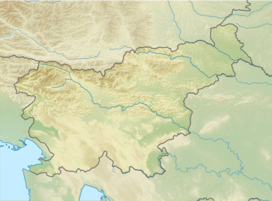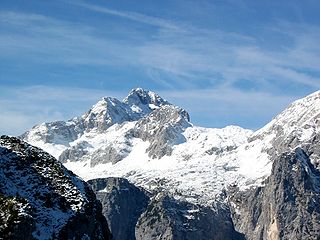
Triglav, with an elevation of 2,863.65 metres (9,395.2 ft), is the highest mountain in Slovenia and the highest peak of the Julian Alps. The mountain is the pre-eminent symbol of the Slovene nation, appearing on the coat of arms and flag of Slovenia. It is the centrepiece of Triglav National Park, Slovenia's only national park. Triglav was also the highest peak in Yugoslavia before Slovenia's independence in 1991.
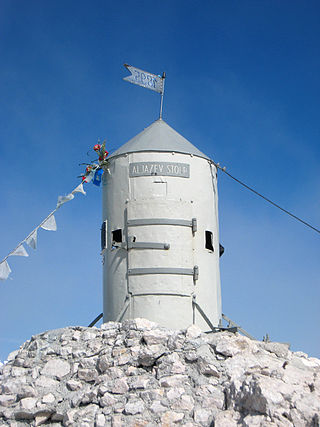
Aljaž Tower or the Triglav Tower is a tower, a storm shelter and a triangulation point on the summit of Mount Triglav in northwestern Slovenia. Along with Triglav, it is a landmark of Slovenia and a symbol of the Slovenehood. The tower was designed by Jakob Aljaž, a priest in the Upper Carniolan village of Dovje, who also had it erected, in 1895. Today it is owned by the state, tended by the Ljubljana Matica Alpine Club and stands on a parcel belonging to the Municipality of Bohinj.
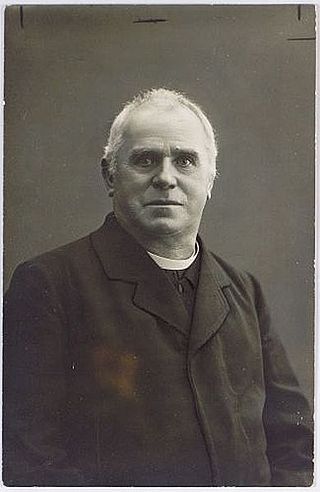
Jakob Aljaž was a Slovene Roman Catholic priest, composer and mountaineer.

The Triglav Lakes Valley is a rocky hanging valley in the Julian Alps in Slovenia, below the sheer sides of Mount Tičarica and Mount Zelnarica southwest of Triglav. The valley is also called the Seven Lakes Valley, although there are ten and not seven lakes in the valley. It is above the tree line and is geologically alpine karst; therefore it has also been termed the Sea of Stone Valley.
The Ljubljana Matica Alpine Club, with its office located in Ljubljana, is by the number of members the largest Alpine club in Slovenia. In 2013, the club had about 2,800 members. It is a member of the Alpine Association of Slovenia. The current president of the club is Tomaž Willenpart.
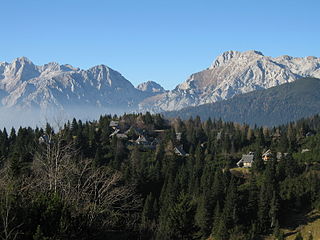
The Big Pasture Plateau is a karstified mountain plateau in the Kamnik–Savinja Alps northeast of Kamnik, Slovenia. It measures 5.8 square kilometres and has an average elevation of 1,500 metres above sea level. Its highest point is Mount Gradišče, at 1,666 m (5,466 ft). There are numerous herders' dwellings that comprise several settlement areas: Velika Planina 'Big Pasture', Mala Planina 'Little Pasture', Gojška Planina 'Gozd Pasture', Tiha Dolina 'Quiet Valley', and others. The Big Pasture Plateau is a tourist destination both in winter as a ski resort and in summer as a place for relaxation.

Razor is a pyramidal mountain in the Julian Alps and the sixth-highest mountain in Slovenia. First ascended by Otto Sendtner in 1842, it is now frequently ascended, with numerous mountain huts available for climbers.

Komna is a mountain karst plateau in the Julian Alps in northwestern Slovenia. It has an elevation from 1,300 metres (4,300 ft) to 1,750 metres (5,740 ft). It has a triangular shape and rises above the Bohinj Basin. To the east, it continues into the Triglav Lakes Valley. The lowest measured temperatures in Slovenia were recorded at Komna in January 2009, reaching −49 °C (−56 °F).
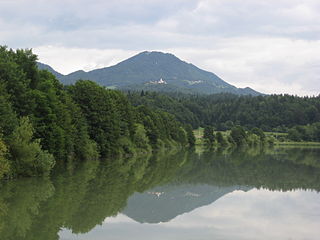
Lisca is a 948-metre (3,110 ft) hill in the eastern part of the Sava Hills in southeastern Slovenia, northwest of Sevnica, north of the Sava, and south of Gračnica Creek. It is the most frequently visited hiking destination in the Sava Hills.

The Municipality of Kranjska Gora is a municipality on the Sava Dolinka River in the Upper Carniola region of northwest Slovenia, close to the Austrian and Italian borders. The seat of the municipality is the town of Kranjska Gora. It borders Italy & Austria.
The Slovenian Mountain Hiking Trail, sometimes also called Transverzala, is a route from Maribor to Ankaran. It covers most of the Slovenian mountain areas including Pohorje, the Julian Alps, the Kamnik-Savinja Alps, the Karawanks, and the southwestern part of Slovenia. It is the oldest hiking track in Europe.

The Triglav Lakes Lodge is a mountain lodge between Double Lake and the artificial Lake Močivec below Mount Tičarica in the heart of the Julian Alps, northwestern Slovenia. The first structure was built in 1880 by an Austrian hiking club. In 1955 and 1988, it was rebuilt and expanded. It has four dining rooms with 150 seats, 13 rooms with 30 beds, and 13 larger sleeping rooms with 170 bunks. The lodge is open from the end of June until the start of October

The Ribnica Lodge is the highest mountain lodge in the Pohorje Mountains. It lies on a small plateau below Little Black Peak in the central area of the Pohorje Hills. The lodge is open all year round. It is accessible by car from Ribnica na Pohorju. There is also a small ski resort with three surface lifts.

The Planika Lodge at Triglav is a mountain hut, which lies on the Ledine plains on the southern side of Mount Triglav. The First hut, also called the Triglav Tempe, was built on 18 September 1871. In 1877, the Austro-German hiking club built a hut called the Maria Theresa Hut. On 13 August 1911, there was another building added called the Maria Theresa Lodge. After World War I, the Slovenian Hiking club took over the hut and renamed it the Aleksander Lodge. The hut was transformed to a border garrison Karaula for a while. In 1945, the Gorje Hiking Club renamed it to Planika Lodge at Triglav. In 1987, Karaula was demolished and a bigger annex was built at its place on 19 August 1992.

Aljaž Lodge in the Vrata Valley is a mountain hut that lies near the stream Triglav Bistrica in the upper end of the Vrata Valley. The hut is named after the Slovene priest and composer Jakob Aljaž (1845–1927), who in 1896 ordered the construction of the first wooden hut in the valley. The original Aljaž Lodge was built in 1904, and rebuilt in 1910 after the previous one was destroyed by an avalanche. Aljaž Lodge is the starting point to ascend the mountains Triglav, Škrlatica and Cmir.

Begunjščica is a ridge mountain in the Karawanks. It rises from the western Smokuč mountain pasture to St. Anne on its eastern side. The mountain has three main peaks, the highest being Big Peak. The western Middle Peak lies a little lower, and the lowest is Begunje Mount Vrtača. Its southern slopes rise over the Draga Valley. The ascent of the mountain is relatively easy and possible throughout the year. In the winter and early spring conditions are favourable for ski touring.
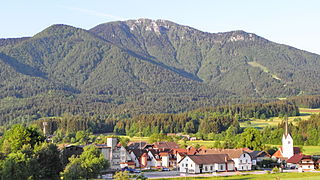
Mount St. Ursula or Plešivec is the easternmost peak of the Karawanks. It lies between the towns of Slovenj Gradec and Črna na Koroškem. There are three villages on the slopes of the mountain: Uršlja Gora, Podgora, and Zgornji Razbor. The mountain offers a panoramic view towards all of Carinthia, the Kozjak Mountains, and the Kamnik–Savinja Alps. Below the peak of Mount St. Ursula stands the Gothic St. Ursula's Church, a TV mast tower, a mountain lodge, 1,670 m or 5,480 ft), and a monument to the soldiers fallen in World War I.. The name Plešivec derives from its grey limestone peak.
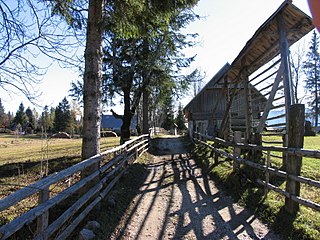
Uskovnica is an Alpine pasture on the Pokljuka Plateau in the Bohinj area belonging to the village of Srednja Vas v Bohinju. The majority of the pasture's cottages are now used as vacation and tourist facilities.
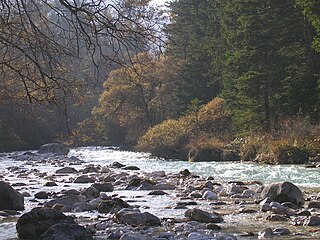
The Triglav Bistrica is a stream that flows through the glacial Vrata Valley southwest of Mojstrana, Slovenia. Its source is below the north face of Mount Triglav in the blind Bukovlje Valley, and it flows past the Aljaž Lodge. In addition to several intermittent tributaries with a flashy character, it also has three constant tributaries, all of them flowing from valleys below the east slope of Mount Škrlatica: Dry Creek, Red Creek, and Peričnik Creek. The Triglav Bistrica empties into the Sava Dolinka at Mojstrana. It falls 400 meters (1,300 ft) during its approximately 10-kilometer (6.2 mi) course.

